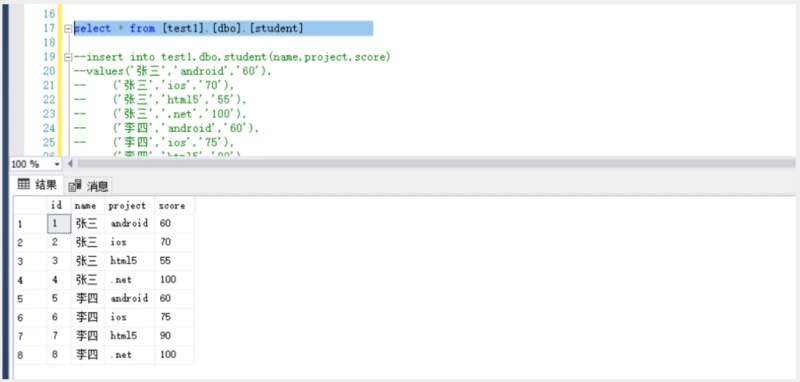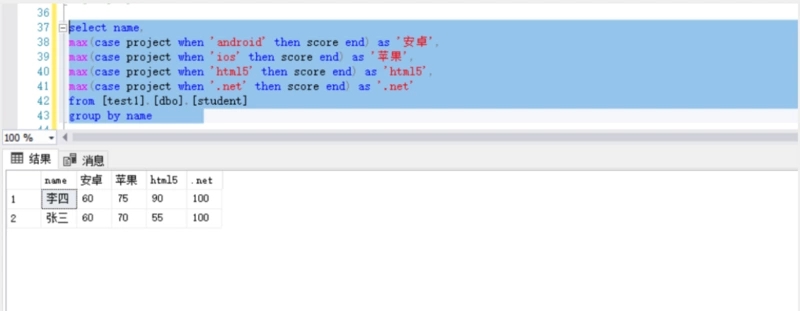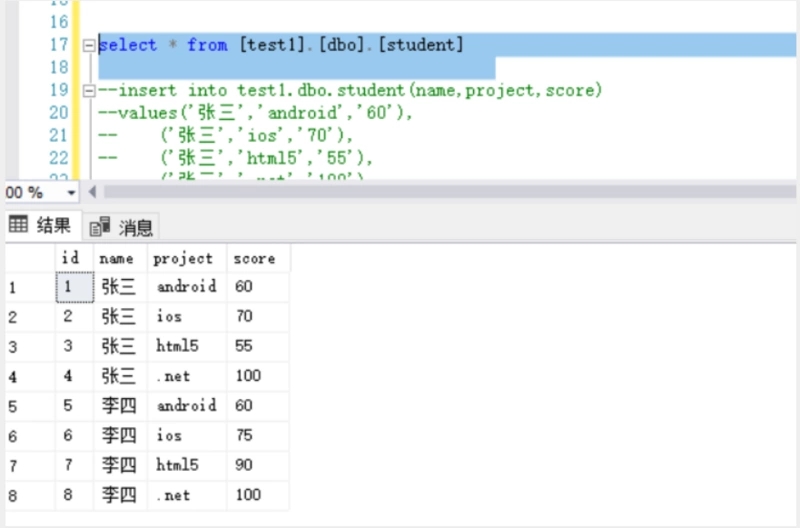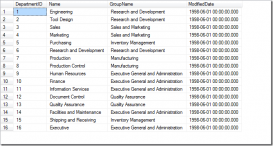准备工作
创建表
|
1
2
3
4
5
6
7
8
9
10
11
12
13
14
|
use [test1]gocreate table [dbo].[student]( [id] [int] identity(1,1) not null, [name] [nvarchar](50) null, [project] [nvarchar](50) null, [score] [int] null, constraint [pk_student] primary key clustered ( [id] asc)with (pad_index = off, statistics_norecompute = off, ignore_dup_key = off, allow_row_locks = on, allow_page_locks = on) on [primary]) on [primary]go |
插入数据
|
1
2
3
4
5
6
7
8
9
|
insert into test1.dbo.student(name,project,score)values('张三','android','60'), ('张三','ios','70'), ('张三','html5','55'), ('张三','.net','100'), ('李四','android','60'), ('李四','ios','75'), ('李四','html5','90'), ('李四','.net','100'); |
使用Case When和聚合函数进行行专列
语法
|
1
2
3
4
|
select column_name,<aggregation function>(<case when expression>) from database.schema.tablegroup by column_name |
语法解析
column_name
数据列列名
aggregation function
聚合函数,常见的有:sum,max,min,avg,count等。
case when expression
case when表达式
示例
|
1
2
3
4
5
6
7
|
select name,max(case project when 'android' then score end) as '安卓',max(case project when 'ios' then score end) as '苹果',max(case project when 'html5' then score end) as 'html5',max(case project when '.net' then score end) as '.net'from [test1].[dbo].[student]group by name |
示例结果
转换前

转换后

使用PIVOT进行行专列
PIVOT通过将表达式中一列中的唯一值转换为输出中的多个列来旋转表值表达式。并PIVOT在最终输出中需要的任何剩余列值上运行聚合,PIVOT提供比一系列复杂的SELECT...CASE语句指定的语法更为简单和可读的语法,PIVOT执行聚合并将可能的多行合并到输出中的单个行中。
语法
|
1
2
3
4
5
6
7
8
9
10
11
12
13
14
15
16
17
|
select <non-pivoted column>, [first pivoted column] as <column name>, [second pivoted column] as <column name>, ... [last pivoted column] as <column name> from (<select query that produces the data>) as <alias for the source query> pivot ( <aggregation function>(<column being aggregated>) for[<column that contains the values that will become column headers>] in ( [first pivoted column], [second pivoted column], ... [last pivoted column]) ) as <alias for the pivot table> <optional order by clause>; |
语法解析
<non-pivoted column>
非聚合列。
[first pivoted column]
第一列列名。
[second pivoted column]
第二列列名。
[last pivoted column]
最后一列列名。
<select query that produces the data>
数据子表。
<alias for the source query>
表别名。
<aggregation function>
聚合函数。
<column being aggregated>
聚合函数列,用于输出值列,最终输出中返回的列(称为分组列)将对其进行分组。
[<column that contains the values that will become column headers>]
转换列,此列返回的唯一值将成为最终结果集中的字段。
[first pivoted column], [second pivoted column], ... [last pivoted column]
数据行中每一行行要转换的列名。
<optional order by clause>
排序规则。
示例
|
1
2
3
4
5
6
7
8
9
10
11
|
select b.Name,b.[android],b.[ios],b.[html5],b.[.net] from(select Name,Project,Score from [test1].[dbo].[student])as apivot( max(Score) for Project in ([android],[ios],[html5],[.net])) as border by b.name desc |
示例结果
转换前

转换后

注意事项
1、如果输出列名不能在表转换列中,则不会执行任何计算。
2、输出的所有列的列名的数据类型必须一致。
总结
以上就是这篇文章的全部内容了,希望本文的内容对大家的学习或者工作具有一定的参考学习价值,谢谢大家对服务器之家的支持。
原文链接:https://segmentfault.com/a/1190000019898109












